Did you know that you can make a DIY first aid spray for your whole family? It’s simple to make and uses natural ingredients, including essential oils, that may help improve minor cuts, scrapes, and scratches.
I came up with this simple first aid spray as a natural alternative to the antibiotic ointments that are so commonly used today and it works very well for my family, including my four children.
Erika Bragdon is a Certified Essential Oil Coach from the Essential Oil Institute.
First Aid Spray – Easy Pain Relief for Kids
My toughest critics (aka my kids!) LOVE this first aid spray. The major advantage to this is when one of them gets a scrape or a boo-boo, a quick squirt of this pain relief spray is often all they need.
Trust me, it’s much easier to spritz this on than it is to try to dab on ointment to a child that’s thrashing around in agony (dramatic, I know).
This first aid spray is gentle and does not sting. Just spray and move on—it’s simple!
Natural First Aid Spray You Can Buy
I also use and highly recommend this First Aid Spray from Herbal Energetics. It’s ready-made and contains even more helpful ingredients than my homemade version.
The only downside I’ve experienced is that this spray can sting when applied to cuts and scrapes, so my kids don’t prefer it.
There are times, however, when I insist on using it because it works SO well. You can buy it here: First Aid Spray
DIY Natural First Aid Spray Ingredients
This DIY natural first aid spray contains a mixture of water, witch hazel, neem oil, and my favorite First Aid essential oil blend from Rocky Mountain Oils. (I will also include recommended individual essential oils later in this post.)
This combination has been quite effective at helping my four kids’ cuts and scrapes improve quickly.
Disclaimer: This homemade first aid spray is meant for minor cuts and wounds and is not intended as a cure. Check with your healthcare provider before use. Please read my post on essential oil common sense safety before using this blend or other essential oils.
Witch Hazel
Witch hazel works as an astringent and may help reduce inflammation along with pain-soothing properties. It’s been used for decades to help treat a variety of skin conditions.
While there are many types out there, I recommend an alcohol-free witch hazel. You can get the version with rose or without depending on your personal preference, but I think the rose adds a little something extra!
Neem Oil
A 2014 study found that topical use of Neem oil, along with the oral use of Haridra powder, was found to be effective in healing chronic non-healing wounds.

Neem oil contains all kinds of properties that are great for skin such as fatty acids, limonoids, and vitamin E. I personally use this neem oil and have found it to work very well in this DIY first aid spray.
Essential Oils
When it comes to using essential oils in this pain relief spray, you can choose to use a pre-mixed blend or you can mix up your own.
Essential Oil Blends
This is the route I usually go because it’s easier and also very effective. I use and recommend an blend called First Aid essential oil blend from Rocky Mountain Oils. It contains rosemary, tea tree, clove bud, and helichrysum italicum essential oils.
Individual Essential Oils
You can try one or more in your first aid spray and discover which combination works best for you and your family. Here’s a good list to get you started:
- Lavender essential oil (Lavandula angustifolia)
- Tea Tree essential oil (Melaleuca alternifolia)
- Clove essential oil (Syzygium aromaticum) – Safety Note: always dilute before use as it is a “hot” oil, meaning it may cause irritation without dilution
- Oregano essential oil (Origanum vulgare) – Safety: always dilute before use as it is a “hot” oil, meaning it may cause irritation without dilution
- Helichrysum essential oil (Helichrysum italicum)
- Rosemary essential oil (Rosmarinus officinalis)
- Myrrh essential oil (Rosmarinus officinalis)
- Cumin essential oil (Cuminum cyminum) – Safety: Do not use cumin essential oil during pregnancy as it can stimulate blood flow to the uterus. Avoid direct sun exposure for up to 12 hours after application as it may cause photo-sensitivity
- Spikenard essential oil (Nardostachys jatamansi) – Safety: Do not use during pregnancy as it may stimulate the uterus.
Which Essential Oil Brand is Best?
For the best results, you will want to choose a high-quality essential oil brand that is 100% pure and offers third-party testing for quality control. Read this post for more info on how to choose essential oils that work for you and your family (beyond the brand.)
My personal favorite essential oil company is Rocky Mountain Oils, followed by Eden’s Garden, and Ancient Apothecary by Dr. Axe.
How to Make a DIY Natural First Aid Spray
There are a few things you’ll need to make this pain relief spray come together.
You’ll need:
- a glass bottle with a spray nozzle- I use this 2 oz size
*
- small metal funnel
, optional
- 1 oz of water
- 1 Tbsp neem oil
- about 3/4 oz alcohol-free witch hazel
- 20-30 drops of essential oils**
- free printable label – download here
*You can use a smaller or larger spray bottle – just adjust the quantities accordingly.
**I use 20 drops of Rocky Mountain Oil’s First Aid essential oil blend along with 10 drops of lavender essential oil for my DIY First Aid Spray. You may use the same or your own preferred combination of essential oils. See below for safety and using this First Aid Spray with young children.
Directions:
Fill your 2-ounce glass bottle about halfway with water.
Add about 1 tablespoon of neem oil. I always estimate as neem oil is messy and it’s harder to measure.
Add 20-30 drops of your preferred essential oils.
Fill the rest of the bottle with witch hazel.
Cap with the spray nozzle.
Optional: print, cut out, and tape on this free printable label we’ve made for you or use a label maker or masking tape to label.
How to Use this Natural First Aid Spray
Always shake well before use to distribute the oils as they tend to separate.
Spray as needed onto minor cuts and scrapes.
If you choose to put on a bandage, gently blot around the wound before applying the bandage so it will stick.
Reapply your natural first aid spray as needed.
For my kids, I usually only apply this once and the cut/scrape improves quickly on its own without further intervention.
First Aid Spray and Young Children:
If you have toddlers or young children, please do your own research and check with your healthcare provider before using this homemade first aid spray.
I hope you enjoy this simple natural first aid spray as much as my family has.
Have a safe and enjoyable summer!
Pin this recipe for later!
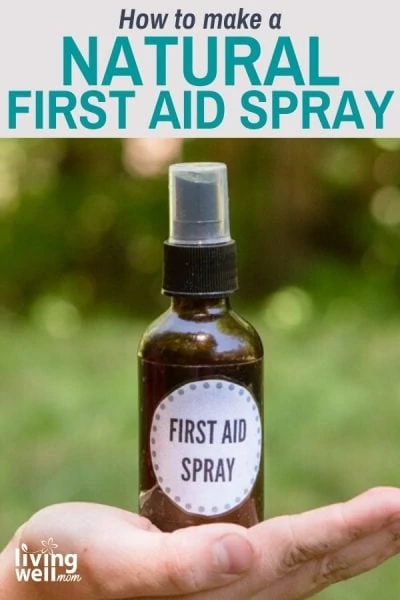
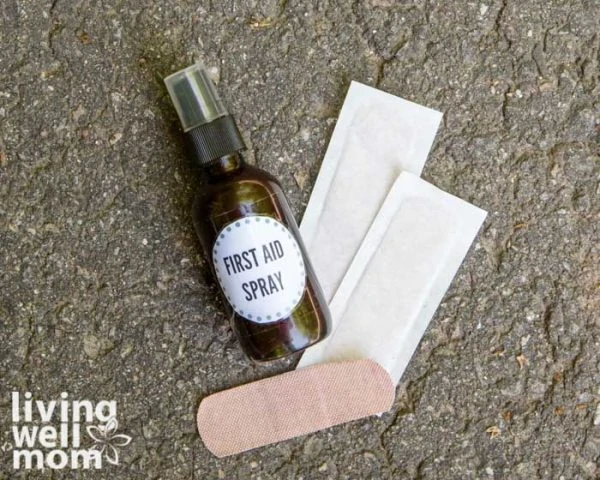
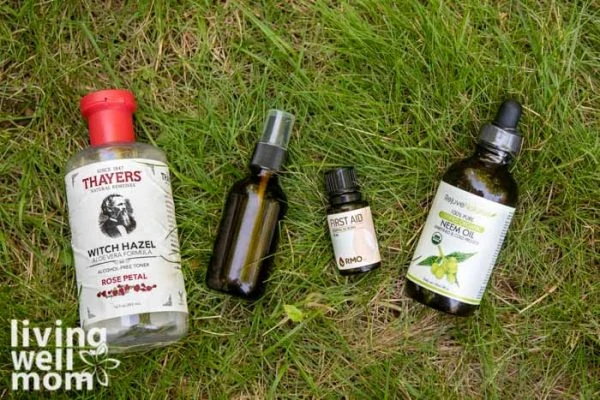
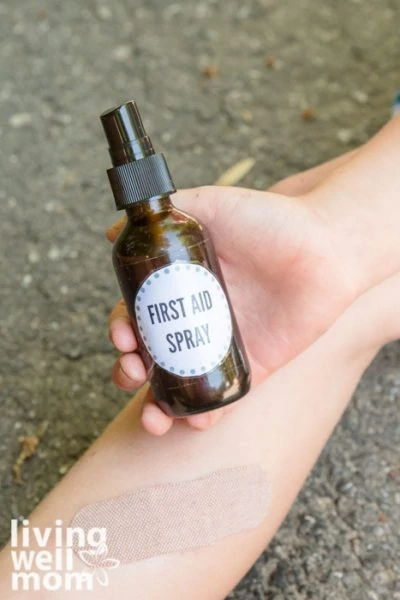



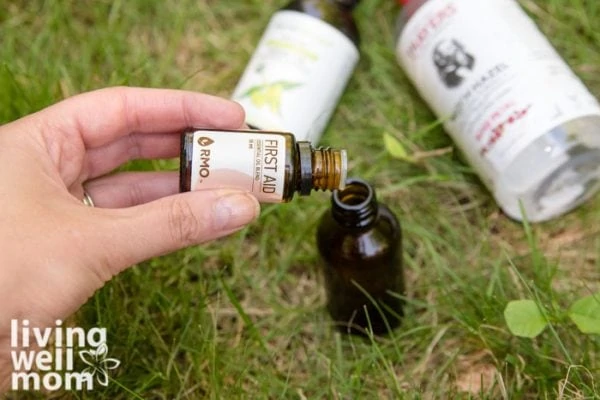
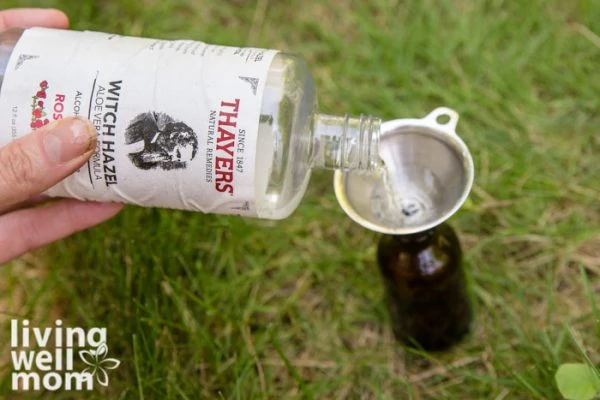
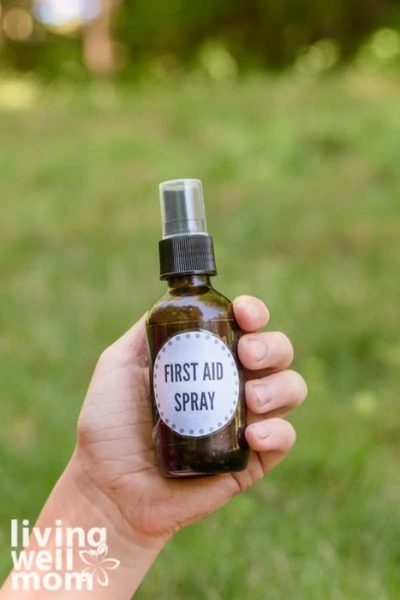
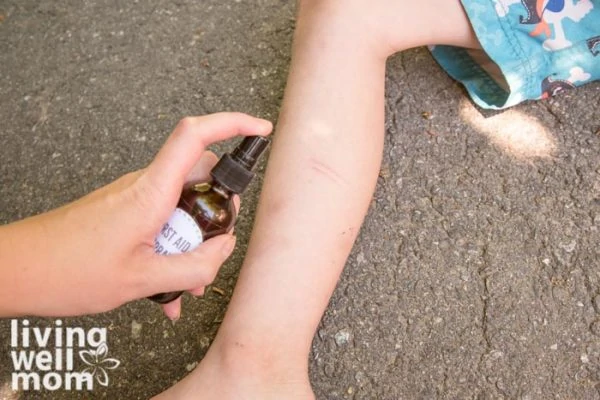


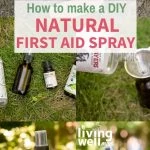
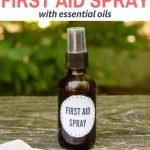
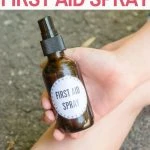
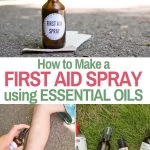
Ipsita kar says
Oh…That’s a Great Idea to make it home. Thanks for sharing this Idea.
Wanda Fuller says
How long does the spray last before going bad/spoiling?
Erika says
The witch hazel acts as a natural preservative – a batch should last several months or more, assuming you don’t store it in the sun or a really hot area. I usually make a fresh bottle each spring and it lasts us well into the fall (unless we use it all sooner).
Krista says
What can I add so it doesn’t separate so quickly?
Erika says
I haven’t found anything that prevents the separation. We just shake it really well before using.